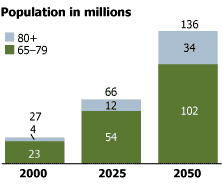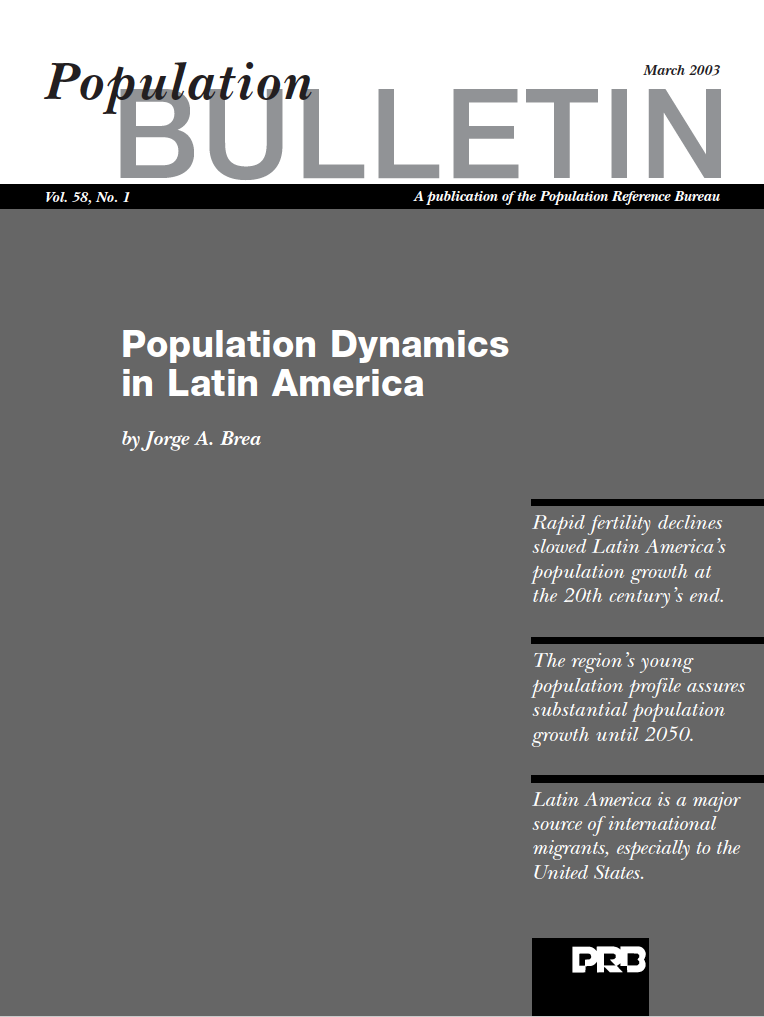
The Graying of Latin America
Product: Population Bulletin, vol. 58, no. 1
Author: PRB
Date: March 6, 2003
Focus Areas
(March 2003) Latin Americans born in the 1960s era of soaring population growth will begin to pass into their 60s by 2020, signaling a surge in the retirement-age population that will last for several decades. The number of Latin Americans age 65 or older is projected to more than double between 2000 and 2025 and to double again by 2050 (see figure). In Colombia, Costa Rica, and Mexico, the number of elderly is projected to triple between 2000 and 2025. The increase will be more modest in Argentina and Uruguay, where population growth was slower in the last half of the 20th century, but the number of elderly will increase by more than half in both countries between 2000 and 2025.
Projection of the Population Age 65 or Older, Latin America, 2000, 2025, and 2050

Source: CELADE, Boletín demográfico 69 (2002): table 11.
The rapidly declining fertility and improving health of adults in Latin America during the past 50 years have also set the scene for a remarkable increase in the elderly’s share of the total population. While those age 65 or older accounted for less than 4 percent of the total population in 1950 and for 5 percent in 2000, they will make up at least 17 percent by 2050. Latin America is considerably younger than the United States, Japan, and most European countries. In the United States, 13 percent of the population was age 65 or older in 2000, while 17 percent of the Japanese population was elderly, and the percentages in both countries are expected to rise.
The aging process is occurring fastest in countries that have seen the most rapid fertility declines. Between 2000 and 2050, the percentage of the population age 65 or older will rise from 10 percent to nearly 27 percent in Cuba, for example, and from 5 percent to 18 percent in Brazil.1
In some countries, especially smaller Central American and Caribbean countries, emigration to the United States has accelerated the aging process. Younger adults are the most likely to migrate abroad to find work, leaving behind the middle-aged and older adults. The most rapid aging — which is already occurring in many countries — often results from the migration of younger adults from rural to urban areas within the same country. International and urban-rural migration can remove the primary breadwinners from a community, depleting the financial support of older residents. Younger relatives working in the cities are unlikely to be able to provide direct care for aging kin in the countryside — although they may be able to provide some financial support.2
The rapid population aging in Latin America, combined with the region’s widespread poverty and economic troubles, will put enormous strains on the governments of many countries in the region, especially as their public sectors are assuming more responsibility for the welfare of citizens. The coming boom in the number of elderly raises questions about how to structure pension programs so they do not encourage early retirement and do not depend on a high ratio of current workers to retirees.3 Uruguay, for example, recently raised the minimum retirement ages from 55 to 60 for women and from 60 to 65 for men. The larger elderly population will also increase demands for health care for chronic diseases, even as many countries are still battling communicable diseases associated with poverty and overcrowding. Providing health care, housing, and economic support for this burgeoning older population will present major challenges for national governments during the 21st century.
References
- CELADE, “América Latina y el Caribe: Estimaciones y proyecciones de población 1950-2050,” Boletín demográfico 69 (2002): part A.
- Kevin Kinsella and Victoria A. Velkoff, “An Aging World: 2001,” International Population Reports P95/01-1 (Washington, DC: U.S. Government Printing Office, 2001): 4955.
- National Research Council, Preparing for an Aging World (Washington, DC: National Academy Press, 2001): 8-14.
Jorge A. Brea is associate professor of geography at Central Michigan University.
Excerpted from PRB’s Population Bulletin “Population Dynamics in Latin America” (PDF: 318KB).

 ">
">